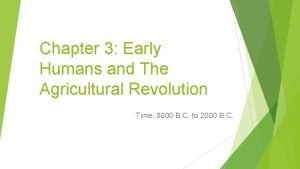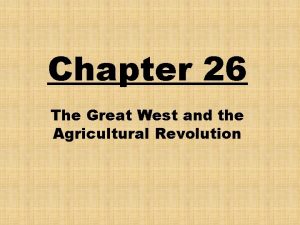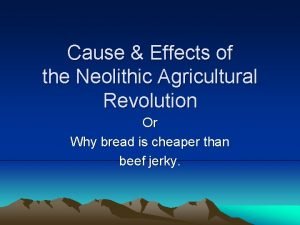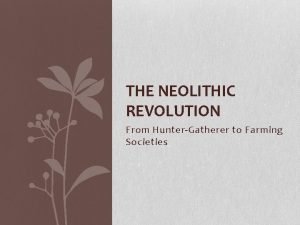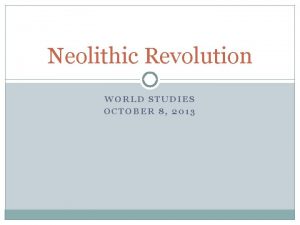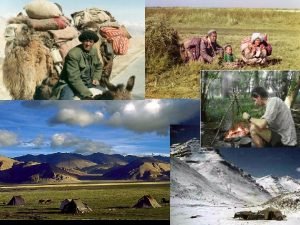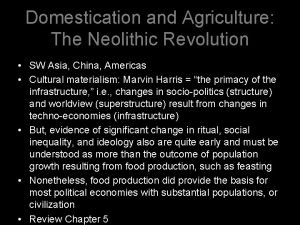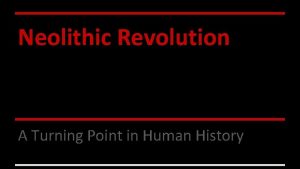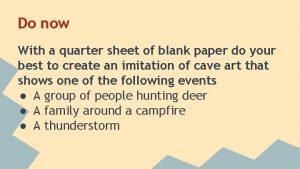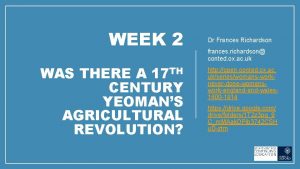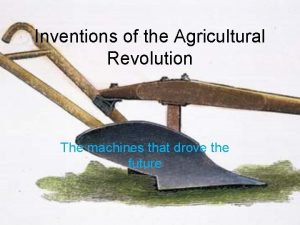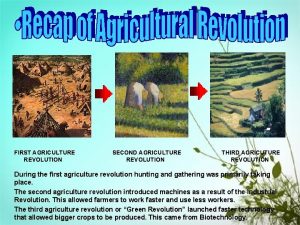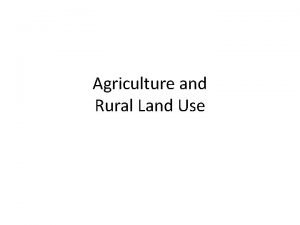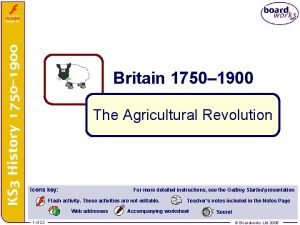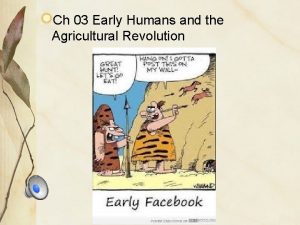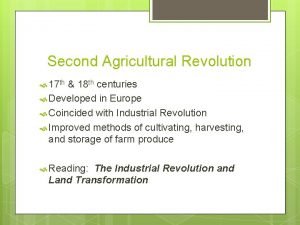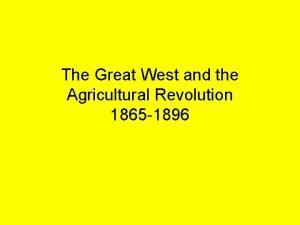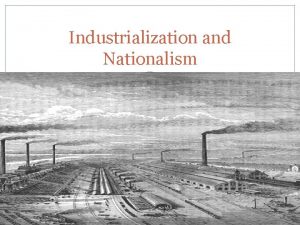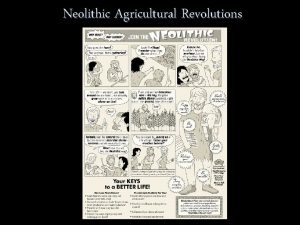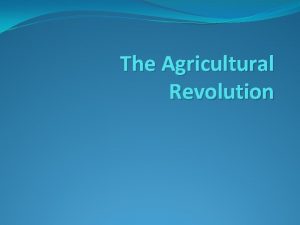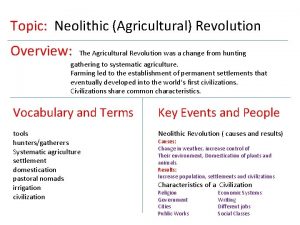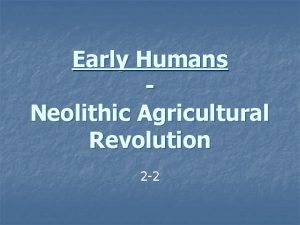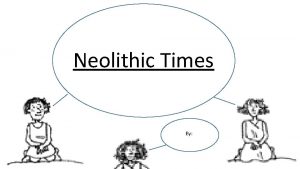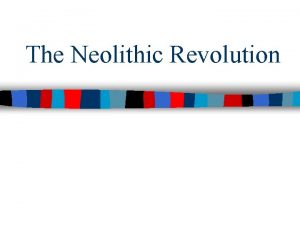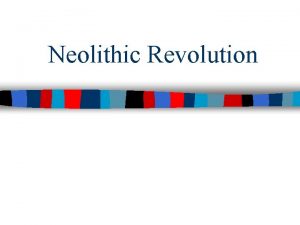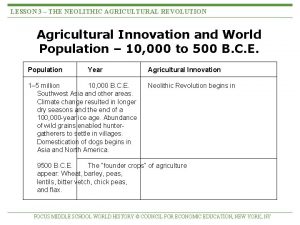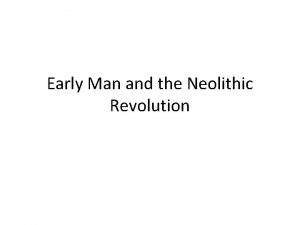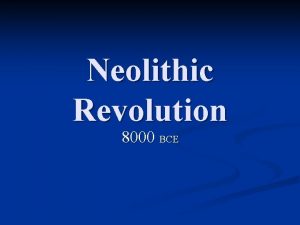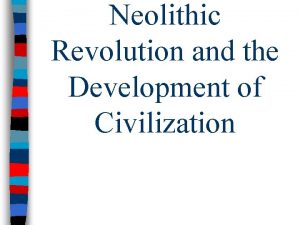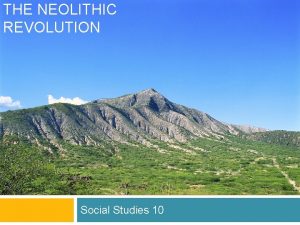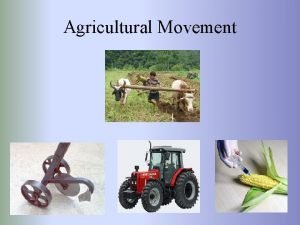The Agricultural Revolution Chapter 3 Lesson 2 Neolithic

























- Slides: 25

The Agricultural Revolution Chapter 3, Lesson 2

Neolithic Times ► Earliest people were nomads. § People who moved from one place to another. ► After the Earth temperature rose, many nomads moved to mild climate and fertile lands. ► A new revolution occurred as people stayed in one location and grew grains and vegetables.

Neolithic Times ► Farming replaced hunting as the main source of food; Along side this people began domesticating animals. § Taming animals to be used by humans. ► Animals could be used for transporting goods, provided meat, milk, and wool.

The Neolithic Age ► Neolithic stone age. Age was the latest period of the § Began around 8, 000 B. C. and lasted around 4, 000 B. C. ► Neolithic is a Greek word for “New Stone. ” § The name is misleading because although new stone tools were made, the age is most known for it’s shift from hunting and gathering to systematic agriculture. § Growing food on a regular basis.

The Neolithic Age ► This change did not occur quickly and people were still hunting through the Mesolithic, or middle stone age.

Big Changes for Humankind ► The Neolithic Age is also known as the Agricultural Revolution. § A revolution is a change that has a big effect on people’s lives. ► Because people had a constant food supply, populations began to grow at a faster rate. Also, people began to give up their nomadic ways. ► The agricultural revolution is sometimes considered the most important event in human history.

Widespread Farming ► By 8, 000 B. C. Southwest Asia was growing wheat and barley. They had also domesticated pigs, cows, goats and sheep. ► Farming than spread into Southeastern Europe. ► By, 4000 B. C. farming was established as an economic activity.

Widespread Farming ► At around 6, 000 B. C. the Nile Valley was growing wheat and barley. § Farming will spread along the Nile. ► In Central Africa certain types of crops emerged. § These were root crops called tubers, which included yams. Also grew fruits like bananas. ► Wheat and barley farming would move eastward to India between 8000 and 5000 B. C.

Widespread Farming ► By 6000 B. C. northern China had millet (a food grain) and had domesticated dogs and pigs. ► By 5000 B. C. farmers in Southeast Asia were growing rice. ► Rice farming would spread into southern China. ► In the Western Hemisphere, between 7000 and 5000 B. C. people in Central America and Mexico were growing corn, squash, and potatoes. § Also domesticated chickens and dogs.

Life in the Neolithic Age ► People would settle near fields so they could plant, grow, and harvest crops more efficiently. ► People also settled near water sources, especially rivers.

Neolithic Communities ► Neolithic farming villages were found throughout Europe, India, Egypt, China and Mexico. ► Jericho was one of the biggest communities and was located in an area between presentday Israel and Jordan called the West Bank. ► Was well established by 8000 B. C. and extended across several acres. § They were surrounded by walls that were several feet thick.

Life in the Neolithic Age ► Another well-known Neolithic Community was Catalhuyuk in Present Day Turkey. ► It was around 6700 and 5700 B. C. § The people in this civilization had a population of about 6, 000, and entered their homes from their rooftops. The inside was decorated with wall paintings. ► They also had shrines. These were holy places. § It had statues of gods and goddesses. Also had statues of women giving birth. § These are examples of religions growing in the Neolithic civilizations.

Life in the Neolithic Age ► Farmers grew fruits, nuts, and different grains on land outside the civilization. ► People grew their own food and kept it in storerooms in their homes. ► They raised sheep, goats and cattle that provided milk and meat. ► They ate fish and bird eggs from nearby low-lying wetlands called marshes. ► Scenes on a wall also show that they hunted.

What Were the Benefits of a Settled Life. ► Protection from weather and animals. ► Steady Food Supplies. ► More people meant more crops. § Excessive food was traded for food they could not get themselves. ► Neolithic people began to take part in economic activities other than farming that suited their talents. This is specialization. § Specialization – the act of training for a particular job.

What Were the Benefits of a Settled Life. ► Some people artisans, or skilled workers. § They made weapons, jewelry, pottery from clay, and baskets and clothes from plant fibers. § Otzi, the Neolithic Iceman, wore a cape made from woven grass fibers. ► They would trade with others for things they did not have.

What Were the Benefits of a Settled Life. ► The roles of men and women would also change. § Men worked in fields farming and herding animals. They were also responsible for growing food and protecting the village. They also emerged as family and community leaders. § Women bore children and made cloth from sheep wool and used bone needles to make clothes from animal furs. They also managed the food supply and other tasks.

What Were the Benefits of a Settled Life. ► The growth of communities did not always bring benefits. § Jordan’s rapid population growth resulted in wood and other supplies to be used up quickly. § This could cause desert like conditions to spread. § Where this type of damaged occurred settlements were abandoned.

The End of the Neolithic Age ► During the late Neolithic Age, people made more technological advances. ► Toolmakers created better farming tools as the need for them arose. § Hoes for digging soil, sickles for cutting grain, and millstones for grinding flour. ► Some people began working with metals including copper. § Experimented with copper to make tools and weapons. These were easier to make than ones of stone.

The End of the Neolithic Age ► Craftspeople in Western Asia discovered that mixing copper and tin formed bronze. § This was a technological breakthrough because bronze was stronger than copper. ► Bronze became widely used between 3000 and 1200 B. C. ► This period is known as Bronze Age. § The time period when people used bronze. ► Few people could afford bronze and continued to use tools and weapons made of stone.

Civilizations Emerge ► Civilizations would begin to develop by the beginning of the Bronze Age. § A civilization is a complex culture. § Civilizations share similar characteristics ► Four of the great river valley civilizations were Mesopotamia, Egypt, India, and China. § These would emerge around 3000 B. C.

Cities and Government ► Civilizations developed cities and governments. § The first civilizations developed in river valleys where fertile land made it easy to grow crops and feed lots of people. § Rivers provided fish and water ► They encouraged trade of goods and ideas. ► River valleys would become the centers of civilizations

Cities and Government ► Governments were created to protect people and food. ► The first government were monarchies § A type of government lead by a king or queen. § They created armies to defend against enemies and made laws to maintain order. § Also appointed officials who managed food supplies and building projects.

Religion ► Religions emerged to help people explain their lives. It helped explain forces of nature and the role of humans in the world. ► Early people believed gods were responsible for a groups survival. ► Priests held religious ceremonies to win the support of the gods. ► Rulers claimed their power was based on the approval of the gods.

Social Structure ► Early Civilizations had Social Class Structure. § People in societies were organized into groups. § This was determined mostly by money or power. § The highest in the chain were usually rulers, priests, government officials and warriors. § They set rules and made important decisions. § Below this were free people, including farmers, artisans, and craftspeople. § At the bottom were enslaved people, most of whom were captured from enemies during wars.

Writing and Art ► People invented ways of writing to pass information on. § They used symbols in place of letters and words. § Writing was important because it helped keep accurate records and to preserve stories. § They also created art for enjoyment and practical purpose. § Artists created works about gods and forces of nature. § They also designed massive buildings that served as places of worship or burial tombs for kings.
 Lesson 2 the neolithic revolution
Lesson 2 the neolithic revolution The third agricultural revolution
The third agricultural revolution Chapter 3 early humans and the agricultural revolution
Chapter 3 early humans and the agricultural revolution Chapter 26 the great west and the agricultural revolution
Chapter 26 the great west and the agricultural revolution Causes and effects of neolithic revolution
Causes and effects of neolithic revolution Neolithic revolution definition
Neolithic revolution definition Neolithic revolution
Neolithic revolution Characteristics of neolithic era
Characteristics of neolithic era Whats neolithic revolution
Whats neolithic revolution What was the neolithic revolution? *
What was the neolithic revolution? * Neolithic revolution
Neolithic revolution Why is the neolithic revolution a turning point in history
Why is the neolithic revolution a turning point in history Anocracy definition ap human geography
Anocracy definition ap human geography Neolithic revolution
Neolithic revolution The agricultural revolution
The agricultural revolution Agricultural revolution inventions
Agricultural revolution inventions First agricultural revolution
First agricultural revolution Disadvantage of green revolution
Disadvantage of green revolution Whittlesey agricultural regions
Whittlesey agricultural regions Agricultural revolution worksheet
Agricultural revolution worksheet Early humans and the agricultural revolution answer key
Early humans and the agricultural revolution answer key Green revolution advantages and disadvantages
Green revolution advantages and disadvantages The second agricultural revolution coincided with
The second agricultural revolution coincided with The great west and the agricultural revolution
The great west and the agricultural revolution Chapter 23 lesson 1 the industrial revolution
Chapter 23 lesson 1 the industrial revolution Lesson quiz 10-1 industrialization and nationalism
Lesson quiz 10-1 industrialization and nationalism


